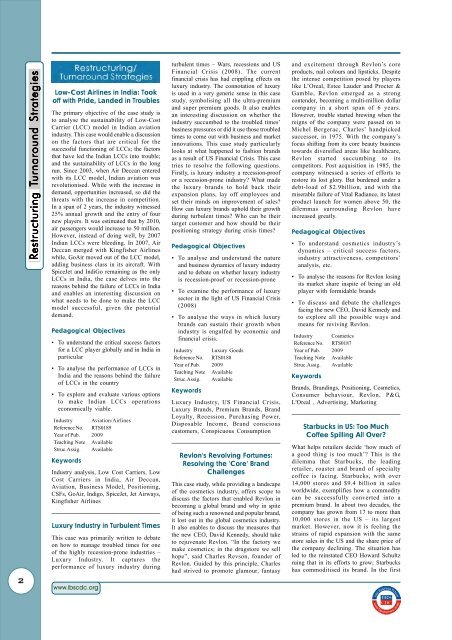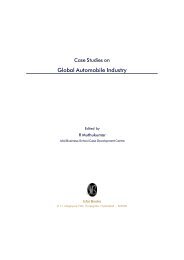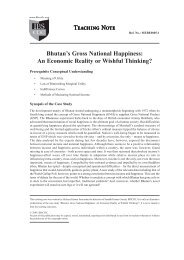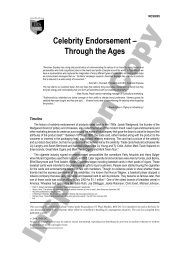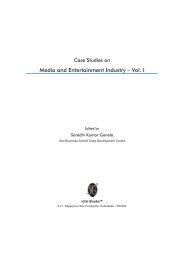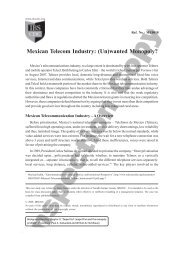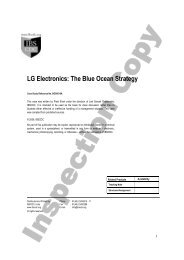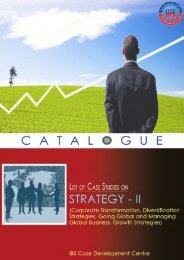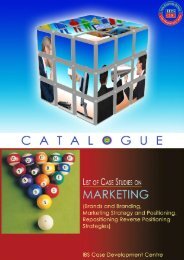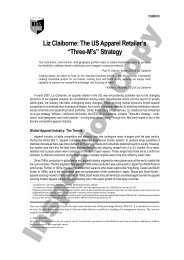List of Case Studies on Strategy - Case Catalogue IV
List of Case Studies on Strategy - Case Catalogue IV
List of Case Studies on Strategy - Case Catalogue IV
Create successful ePaper yourself
Turn your PDF publications into a flip-book with our unique Google optimized e-Paper software.
2<br />
Restructuring estructuring T TTurnaround<br />
T urnaround Strategies<br />
Strategies<br />
Low-Cost Airlines in India: Took<br />
<str<strong>on</strong>g>of</str<strong>on</strong>g>f with Pride, Landed in Troubles<br />
The primary objective <str<strong>on</strong>g>of</str<strong>on</strong>g> the case study is<br />
to analyse the sustainability <str<strong>on</strong>g>of</str<strong>on</strong>g> Low-Cost<br />
Carrier (LCC) model in Indian aviati<strong>on</strong><br />
industry. This case would enable a discussi<strong>on</strong><br />
<strong>on</strong> the factors that are critical for the<br />
successful functi<strong>on</strong>ing <str<strong>on</strong>g>of</str<strong>on</strong>g> LCCs; the factors<br />
that have led the Indian LCCs into trouble;<br />
and the sustainability <str<strong>on</strong>g>of</str<strong>on</strong>g> LCCs in the l<strong>on</strong>g<br />
run. Since 2003, when Air Deccan entered<br />
with its LCC model, Indian aviati<strong>on</strong> was<br />
revoluti<strong>on</strong>ised. While with the increase in<br />
demand, opportunities increased, so did the<br />
threats with the increase in competiti<strong>on</strong>.<br />
In a span <str<strong>on</strong>g>of</str<strong>on</strong>g> 2 years, the industry witnessed<br />
25% annual growth and the entry <str<strong>on</strong>g>of</str<strong>on</strong>g> four<br />
new players. It was estimated that by 2010,<br />
air passengers would increase to 50 milli<strong>on</strong>.<br />
However, instead <str<strong>on</strong>g>of</str<strong>on</strong>g> doing well, by 2007<br />
Indian LCCs were bleeding. In 2007, Air<br />
Deccan merged with Kingfisher Airlines<br />
while, GoAir moved out <str<strong>on</strong>g>of</str<strong>on</strong>g> the LCC model,<br />
adding business class in its aircraft. With<br />
SpiceJet and IndiGo remaining as the <strong>on</strong>ly<br />
LCCs in India, the case delves into the<br />
reas<strong>on</strong>s behind the failure <str<strong>on</strong>g>of</str<strong>on</strong>g> LCCs in India<br />
and enables an interesting discussi<strong>on</strong> <strong>on</strong><br />
what needs to be d<strong>on</strong>e to make the LCC<br />
model successful, given the potential<br />
demand.<br />
Pedagogical Objectives<br />
• To understand the critical success factors<br />
for a LCC player globally and in India in<br />
particular<br />
• To analyse the performance <str<strong>on</strong>g>of</str<strong>on</strong>g> LCCs in<br />
India and the reas<strong>on</strong>s behind the failure<br />
<str<strong>on</strong>g>of</str<strong>on</strong>g> LCCs in the country<br />
• To explore and evaluate various opti<strong>on</strong>s<br />
to make Indian LCCs operati<strong>on</strong>s<br />
ec<strong>on</strong>omically viable.<br />
Industry Aviati<strong>on</strong>/Airlines<br />
Reference No. RTS0189<br />
Year <str<strong>on</strong>g>of</str<strong>on</strong>g> Pub. 2009<br />
Teaching Note Available<br />
Struc.Assig. Available<br />
Keywords<br />
Industry analysis, Low Cost Carriers, Low<br />
Cost Carriers in India, Air Deccan,<br />
Aviati<strong>on</strong>, Business Model, Positi<strong>on</strong>ing,<br />
CSFs, GoAir, Indigo, SpiceJet, Jet Airways,<br />
Kingfisher Airlines<br />
Luxury Industry in Turbulent Times<br />
This case was primarily written to debate<br />
<strong>on</strong> how to manage troubled times for <strong>on</strong>e<br />
<str<strong>on</strong>g>of</str<strong>on</strong>g> the highly recessi<strong>on</strong>-pr<strong>on</strong>e industries –<br />
Luxury Industry. It captures the<br />
performance <str<strong>on</strong>g>of</str<strong>on</strong>g> luxury industry during<br />
www.ibscdc.org<br />
turbulent times – Wars, recessi<strong>on</strong>s and US<br />
Financial Crisis (2008). The current<br />
financial crisis has had crippling effects <strong>on</strong><br />
luxury industry. The c<strong>on</strong>notati<strong>on</strong> <str<strong>on</strong>g>of</str<strong>on</strong>g> luxury<br />
is used in a very generic sense in this case<br />
study, symbolising all the ultra-premium<br />
and super premium goods. It also enables<br />
an interesting discussi<strong>on</strong> <strong>on</strong> whether the<br />
industry succumbed to the troubled times’<br />
business pressures or did it use those troubled<br />
times to come out with business and market<br />
innovati<strong>on</strong>s. This case study particularly<br />
looks at what happened to fashi<strong>on</strong> brands<br />
as a result <str<strong>on</strong>g>of</str<strong>on</strong>g> US Financial Crisis. This case<br />
tries to resolve the following questi<strong>on</strong>s.<br />
Firstly, is luxury industry a recessi<strong>on</strong>-pro<str<strong>on</strong>g>of</str<strong>on</strong>g><br />
or a recessi<strong>on</strong>-pr<strong>on</strong>e industry? What made<br />
the luxury brands to hold back their<br />
expansi<strong>on</strong> plans, lay <str<strong>on</strong>g>of</str<strong>on</strong>g>f employees and<br />
set their minds <strong>on</strong> improvement <str<strong>on</strong>g>of</str<strong>on</strong>g> sales?<br />
How can luxury brands uphold their growth<br />
during turbulent times? Who can be their<br />
target customer and how should be their<br />
positi<strong>on</strong>ing strategy during crisis times?<br />
Pedagogical Objectives<br />
• To analyse and understand the nature<br />
and business dynamics <str<strong>on</strong>g>of</str<strong>on</strong>g> luxury industry<br />
and to debate <strong>on</strong> whether luxury industry<br />
is recessi<strong>on</strong>-pro<str<strong>on</strong>g>of</str<strong>on</strong>g> or recessi<strong>on</strong>-pr<strong>on</strong>e<br />
• To examine the performance <str<strong>on</strong>g>of</str<strong>on</strong>g> luxury<br />
sector in the light <str<strong>on</strong>g>of</str<strong>on</strong>g> US Financial Crisis<br />
(2008)<br />
• To analyse the ways in which luxury<br />
brands can sustain their growth when<br />
industry is engulfed by ec<strong>on</strong>omic and<br />
financial crisis.<br />
Industry Luxury Goods<br />
Reference No. RTS0188<br />
Year <str<strong>on</strong>g>of</str<strong>on</strong>g> Pub. 2009<br />
Teaching Note Available<br />
Struc.Assig. Available<br />
Keywords<br />
Luxury Industry, US Financial Crisis,<br />
Luxury Brands, Premium Brands, Brand<br />
Loyalty, Recessi<strong>on</strong>, Purchasing Power,<br />
Disposable Income, Brand c<strong>on</strong>scious<br />
customers, C<strong>on</strong>spicuous C<strong>on</strong>sumpti<strong>on</strong><br />
Revl<strong>on</strong>'s Revolving Fortunes:<br />
Resolving the 'Core' Brand<br />
Challenges<br />
This case study, while providing a landscape<br />
<str<strong>on</strong>g>of</str<strong>on</strong>g> the cosmetics industry, <str<strong>on</strong>g>of</str<strong>on</strong>g>fers scope to<br />
discuss the factors that enabled Revl<strong>on</strong> in<br />
becoming a global brand and why in spite<br />
<str<strong>on</strong>g>of</str<strong>on</strong>g> being such a renowned and popular brand,<br />
it lost out in the global cosmetics industry.<br />
It also enables to discuss the measures that<br />
the new CEO, David Kennedy, should take<br />
to rejuvenate Revl<strong>on</strong>. “In the factory we<br />
make cosmetics; in the drugstore we sell<br />
hope”, said Charles Revs<strong>on</strong>, founder <str<strong>on</strong>g>of</str<strong>on</strong>g><br />
Revl<strong>on</strong>. Guided by this principle, Charles<br />
had strived to promote glamour, fantasy<br />
and excitement through Revl<strong>on</strong>’s core<br />
products, nail colours and lipsticks. Despite<br />
the intense competiti<strong>on</strong> posed by players<br />
like L’Oreal, Estee Lauder and Procter &<br />
Gamble, Revl<strong>on</strong> emerged as a str<strong>on</strong>g<br />
c<strong>on</strong>tender, becoming a multi-milli<strong>on</strong> dollar<br />
company in a short span <str<strong>on</strong>g>of</str<strong>on</strong>g> 6 years.<br />
However, trouble started brewing when the<br />
reigns <str<strong>on</strong>g>of</str<strong>on</strong>g> the company were passed <strong>on</strong> to<br />
Michel Bergerac, Charles’ handpicked<br />
successor, in 1975. With the company’s<br />
focus shifting from its core beauty business<br />
towards diversified areas like healthcare,<br />
Revl<strong>on</strong> started succumbing to its<br />
competitors. Post acquisiti<strong>on</strong> in 1985, the<br />
company witnessed a series <str<strong>on</strong>g>of</str<strong>on</strong>g> efforts to<br />
restore its lost glory. But burdened under a<br />
debt-load <str<strong>on</strong>g>of</str<strong>on</strong>g> $2.9billi<strong>on</strong>, and with the<br />
miserable failure <str<strong>on</strong>g>of</str<strong>on</strong>g> Vital Radiance, its latest<br />
product launch for women above 50, the<br />
dilemmas surrounding Revl<strong>on</strong> have<br />
increased greatly.<br />
Pedagogical Objectives<br />
• To understand cosmetics industry’s<br />
dynamics – critical success factors,<br />
industry attractiveness, competitors’<br />
analysis, etc.<br />
• To analyse the reas<strong>on</strong>s for Revl<strong>on</strong> losing<br />
its market share inspite <str<strong>on</strong>g>of</str<strong>on</strong>g> being an old<br />
player with formidable brands<br />
• To discuss and debate the challenges<br />
facing the new CEO, David Kennedy and<br />
to explore all the possible ways and<br />
means for reviving Revl<strong>on</strong>.<br />
Industry Cosmetics<br />
Reference No. RTS0187<br />
Year <str<strong>on</strong>g>of</str<strong>on</strong>g> Pub. 2009<br />
Teaching Note Available<br />
Struc.Assig. Available<br />
Keywords<br />
Brands, Brandings, Positi<strong>on</strong>ing, Cosmetics,<br />
C<strong>on</strong>sumer behaviour, Revl<strong>on</strong>, P&G,<br />
L'Oreal , Advertising, Marketing<br />
Starbucks in US: Too Much<br />
C<str<strong>on</strong>g>of</str<strong>on</strong>g>fee Spilling All Over?<br />
What helps retailers decide ‘how much <str<strong>on</strong>g>of</str<strong>on</strong>g><br />
a good thing is too much’? This is the<br />
dilemma that Starbucks, the leading<br />
retailer, roaster and brand <str<strong>on</strong>g>of</str<strong>on</strong>g> specialty<br />
c<str<strong>on</strong>g>of</str<strong>on</strong>g>fee is facing. Starbucks, with over<br />
14,000 stores and $9.4 billi<strong>on</strong> in sales<br />
worldwide, exemplifies how a commodity<br />
can be successfully c<strong>on</strong>verted into a<br />
premium brand. In about two decades, the<br />
company has grown from 17 to more than<br />
10,000 stores in the US – its largest<br />
market. However, now it is feeling the<br />
strains <str<strong>on</strong>g>of</str<strong>on</strong>g> rapid expansi<strong>on</strong> with the same<br />
store sales in the US and the share price <str<strong>on</strong>g>of</str<strong>on</strong>g><br />
the company declining. The situati<strong>on</strong> has<br />
led to the reinstated CEO Howard Schultz<br />
ruing that in its efforts to grow; Starbucks<br />
has commoditised its brand. In the first


